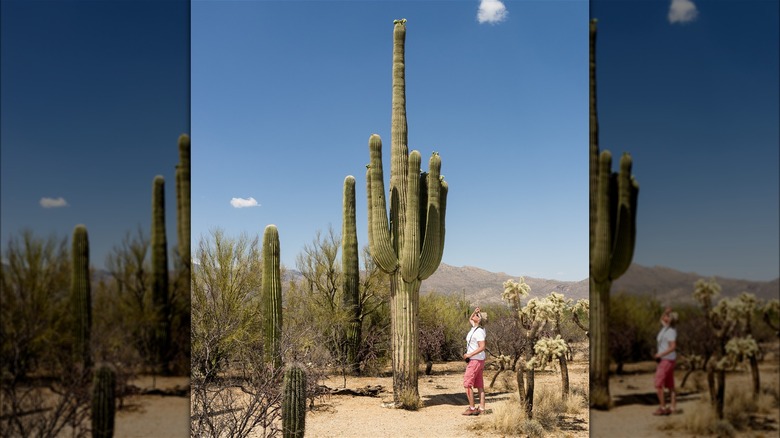Destinations United States
Lexi Kassler
It’s undeniable that cacti are some of the coolest and strangest plants on Earth. They can go months without water, are used as nests for some desert wildlife, and can even produce fruits and colorful flowers. One cactus species in particular — the Saguaro — is the largest cactus in the United States. To see them, you’ll have to head to Saguaro National Park.
Located in Tucson, Arizona, this national park is home to the Saguaro cacti, which only grow in the Sonoran Desert. The environment here is uniquely suited to these cacti, allowing them to flourish and grow up to a whopping 60 feet tall and weigh as much as 4,800 pounds!
Per the National Park Service, it’s difficult to determine the age of an individual Saguaro since they are slow growers, and the rate of their growth is impacted by a number of factors. However, studies and photo records have determined these incredible cacti can live up to 200 years old. The oldest Saguaro in the world, Old Grandaddy, was also located in Saguaro National Park. This Saguaro was 300 years old when it began to die in the ’90s, making it the oldest cacti ever recorded.
The best way to visit Saguaro National Park

Pchoui/Getty Images
While the images of Saguaros alone are quite impressive, we believe seeing them in person is bucket-list-worthy. Staring up at these four and five-story-tall creatures is an experience unlike anything else. So, how do you get to the Saguaro National Park? Well, there are two different sections of the park: The Rincon Mountain District, also known as Saguaro East, and the Tucson Mountain District, also known as Saguaro West.
Once you arrive, both sections of the park have scenic loops you can drive, which will take you through the cactus forests. In Saguaro East, you’ll find the eight-mile paved Cactus Forest Scenic Loop Drive. The Saguaro West Scenic Bajada Loop Drive, on the other hand, is unpaved but still accessible for low-clearance vehicles. Biking is permitted on both of these loops — however, some trails prohibit bikes, so be sure to check out the National Park Service for specific information on the trail you intend to visit.
There are also plenty of scenic hiking trails in both sections of the park. The Loma Verde Trail in Saguaro East is an easy 1.5-hour hike with tons of plants and wildlife to check out. If you’re looking for something a bit more challenging, hike Wasson Peak — the tallest mountain in Saguaro West — which is about 6.7 miles long and provides fantastic panoramic views of the park. Well worth the effort!
Stay safe while visiting the park

Joshua Resnick/Shutterstock
If you visit Saguaro National Park in the summer, expect extreme temperatures above 100 degrees Fahrenheit. The summers in the desert are no joke, so come prepared with plenty of water and electrolytes. Despite the hot weather, you might prefer to visit during the late spring, between April and June, since the flowers will bloom in the park. However, many say the best time to visit is in winter when the temperature is mild.
Even if you visit during the winter, you still want to be mindful of the sun and the dry conditions. Since there are also no concessions inside the park, bring your own water and food, and remember to wear a hat and regularly apply sunscreen. You’ll also want to make sure someone knows where you are and when you plan to return since the cell signals inside the park are fairly limited.
Finally, this is the great outdoors of the American Southwest … meaning you will share the trails with some exciting but potentially dangerous wildlife and plants. Avoid touching the cacti as they have sharp spines, which may be difficult to remove without tweezers (and don’t break this cactus rule when visiting, either). Snakes, “killer” bees, and mountain lions may also be found, so be vigilant. On a heartwarming final note, we want you to know that being informed is the first step to staying safe. So, as long as you come prepared and do your research, there is no need to worry. We hope you enjoy the incredible Saguaros of the Saguaro National Park!

